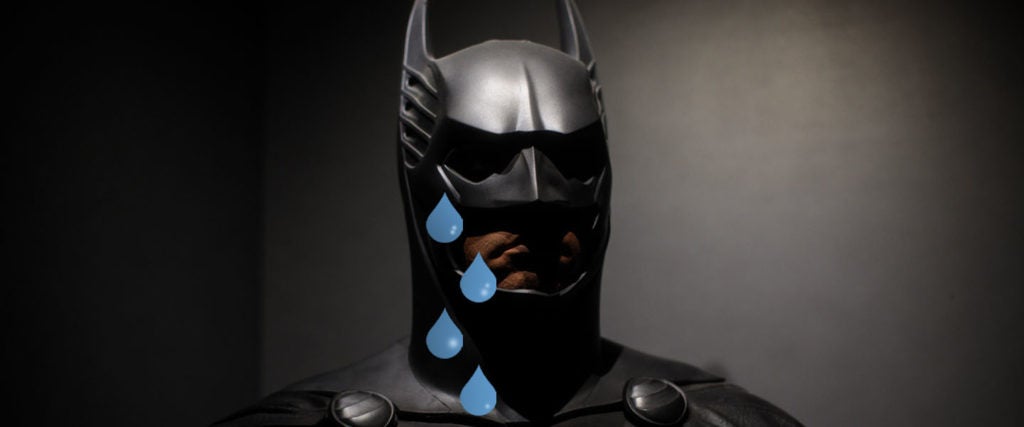There is a compelling moment in Batman Begins when Bruce Wayne — played by Chistian Bale — reunites with a childhood friend, Rachel Dawes, played by Katie Holmes. He tries to make excuses for his playboy ways, saying that it isn’t really who he is inside. She responds by saying, “It’s not who you are underneath, it’s what you do that defines you.”
Ouch.
Later on, after saving Rachel’s life, she asks Batman (Bruce Wayne) what his name is. Still wounded by her earlier rebuff, he throws her words back at her, while also unburdening himself of his deepest secret: Bruce Wayne and Batman are one and the same. “It’s not who I am underneath, but what I do that defines me,” he offers smugly.
To that, I say, “Really, Batman?”
Sure, he’s a superhero, but underneath the mask, Batman is just another in a long list of men who mistakenly think that because they’ve managed to “make it work,” they don’t need to deal with their unresolved trauma. Yes, he knows he’s broken, but he considers therapy a waste of time, and he’s got countless disastrous personal relationships to prove it.
Even someone who knows almost nothing about Batman probably knows about his early childhood trauma: When he was just a boy, Bruce Wayne witnessed his parents being murdered right in front of him. While such a catastrophic event would lead most children into intensive therapy, it led to Bruce to become a vigilante crime fighter.
According to Drea Letamendi, a clinical psychologist at UCLA and host of The Arkham Sessions, a podcast about the psychology of Batman, what Bruce Wayne experienced as a child is called interpersonal trauma. “These are human driven so they’re much more difficult to resolve and recover from because there’s a victim involved,” she explains. “This wasn’t an accident, it was intentional, and it also put him in a position of danger. Recovery from a childhood trauma due to such a profound experience is imperative to start right away. One shouldn’t wait until adulthood to begin working on the healing process.”
Bruce Wayne, of course, did the exact opposite, and per Letamendi, he’s still suffering from the consequences — classic symptoms of PTSD (including emotional distress), an inability to be close to others and flashbacks and nightmares. She also believes he has an addictive personality, which in his case expresses itself through thrill-seeking. Essentially, he maintains a lifestyle that gives him an adrenaline rush because it’s the only thing that makes him feel alive.
In Bruce Wayne’s mind, however, he’s used his trauma for good. And although he’s not totally wrong, deep down, he’s a powder keg that could explode at any moment. Therapy obviously would help him, but he rejects it.
In other words, Batman is no different than a lot of men — and I’m not just talking about the ones I date.
“Psychotherapy was originally created by men to treat women,” says Ronald Levant, former head of the American Psychological Association, explaining why there’s a stigma around men seeking treatment for mental illness. Women are still more likely than men to seek treatment (29 percent to 17 percent), and in large part, that’s because treating men and boys for their specific needs has lagged behind other groups. In fact, the APA only finally released its Guidelines for Psychological Practices with Boys and Men in 2018, years after guidelines were published for other groups, including women and the LGBTQ community. (Needless to say, the stigma creates real-world problems for men — and everyone else in their lives; one of the more alarming statistics is that men are 3.5 times more likely to die by suicide than women.)
As such, psychologists are studying ways to treat men more effectively. One of the suggestions in an Australian study is that men prefer more action-oriented therapies over talking-centered ones.
Which is kinda what Batman is doing. Letamendi calls this post-traumatic growth, or the ability for an individual to interpret a traumatic event in a way that propels them into a motivating life objective. “It’s essentially giving them a reason to live; they can do better and do good, by impacting society or the community,” she tells me. “He’s accessing all of his resources and abilities, and finding ways that he can overcompensate for a profound experience he had as a child and work toward building a better self.”
The thing is, that’s not really a sustainable strategy. “I’d say that sometimes it works and sometimes it doesn’t,” Letamendi continues. “His ability to overcome trauma is seen as among his great achievements, but he continues to hold onto pain, which causes him great turmoil.”
According to archivist Londyn Jackson, creator of the History of Batman YouTube Channel, Batman can feel tremendous guilt when he’s unable to protect those he cares about. Case in point: The death of the second Robin, Jason Todd, which leaves Batman in enormous emotional pain, plagued by regret and self-blame. He tries to bury it, but his trauma manifests itself in highly negative ways. “Typically when Batman is physically fighting, mentally he’s recalling past episodes, such as the paralyzation of Barbara Gordon’s Batgirl by the Joker in Alan Moore’s Batman: The Killing Joke,” Jackson says. “His style and temper is hardly controlled, and at times, it can get the best of him, which goes against his moral code to not kill his enemies.”
Batman’s pain has also been weaponized against him. In particular, Jackson says the Scarecrow exploits this to great effect. “His weapon of choice is highly potent fear toxins,” she explains. “So when Scarecrow exposes Bruce’s Dark Knight to the toxins, he hallucinates past experiences, especially his parents’ death. Usually Batman is the one striking fear into the hearts of criminals. When he has to face his own fears, though, it can be a powerful lesson about the character’s humanity, which ultimately defines him and his crusade.”
But while Batman can try to outrun his brokenness, he can’t outrun his intimacy issues. His interpersonal relationships are underdeveloped, and those that aren’t, he struggles to maintain. “He wants love and belongingness and to depend on others,” Letamendi says, “but why grow to depend on another person, if they may be taken from you?”
Does Batman know he’s fucked up in this way? “I think he’s fully aware that he’s a troubled person, but he sees it as being self-sacrificing,” Letamendi continues. “He sees himself as a martyr. He may even believe he deserves pain — and there’s some narcissism in that.”
To that end, sometimes in her work as a therapist, she’ll describe the impulse to be a martyr as “going Batman.” “Trauma survivors often feel like they don’t have permission to get help — that they have to hold on and own what happened to them,” she says. “I think that’s the case for him. Like, he wouldn’t even consider getting professional health.”
Ironically, the fact that Batman is suffering and broken is why we’re so drawn to him. “I don’t have the same connection to someone like Superman,” Letamendi admits. “Batman is a work in progress. He has a real emotional vulnerability, and he has a lot of work to do as a person. I want to see him grow. I want to see how he recovers.”
Maybe he is the hero we all deserve, after all.

